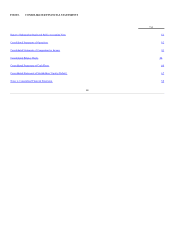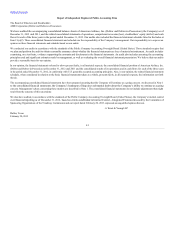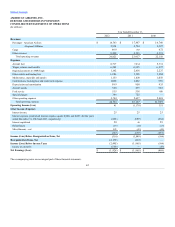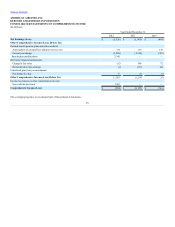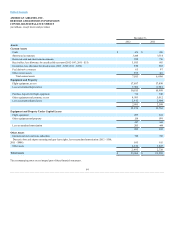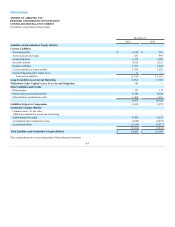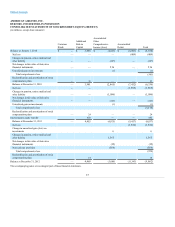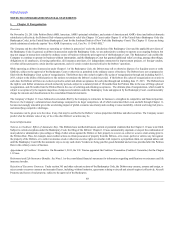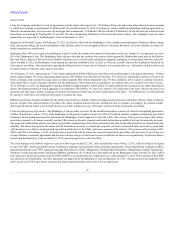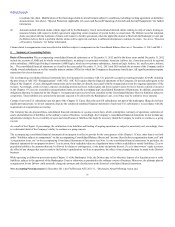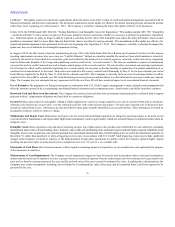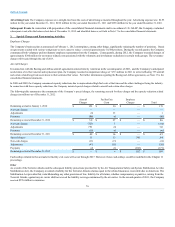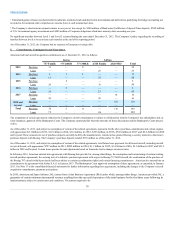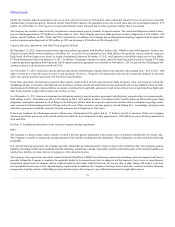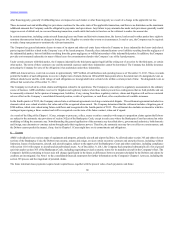American Airlines 2012 Annual Report Download - page 70
Download and view the complete annual report
Please find page 70 of the 2012 American Airlines annual report below. You can navigate through the pages in the report by either clicking on the pages listed below, or by using the keyword search tool below to find specific information within the annual report.
Table of Contents
lessor in 2013.
Lastly, the Company entered into a series of agreements with the lender with respect to its 216 Embraer RJ aircraft and certain other interested parties pursuant
to which the Company (i) surrendered 18 Embraer RJ 135 aircraft on June 21, 2012, (ii) subject to certain conditions (including reaching agreement on
definitive documentation), will restructure the mortgage debt encumbering 59 Embraer 140 aircraft and 68 Embraer 145 aircraft and (iii) transferred and
leased back its remaining 21 Embraer RJ 135 aircraft. The debt encumbering 50 Embraer 145 aircraft will not be reduced. The Company's entry into these
transactions was approved by the Bankruptcy Court on November 8, 2012.
Magnitude of Potential Claims. On February 27, 2012, the Debtors filed with the Bankruptcy Court schedules and statements of financial affairs setting
forth, among other things, the assets and liabilities of the Debtors, subject to the assumptions filed in connection therewith. All of the schedules are subject to
further amendment or modification.
Bankruptcy Rule 3003(c)(3) requires the Bankruptcy Court to fix the time within which proofs of claim must be filed in a Chapter 11 case pursuant to section
501 of the Bankruptcy Code. This Bankruptcy Rule also provides that any creditor who asserts a claim against the Debtors that arose prior to the Petition
Date and whose claim (i) is not listed on the Debtors' schedules or (ii) is listed on the schedules as disputed, contingent, or unliquidated, must file a proof of
claim. On May 4, 2012, the Bankruptcy Court entered an order that established July 16, 2012 at 5:00 p.m. (Eastern Time) as the deadline to file proofs of
claim against any Debtor. More information regarding the filing of proofs of claim can be obtained at www.amrcaseinfo.com. Information on this website is not
incorporated into or otherwise made a part of this report.
As of February 13, 2013, approximately 13,366 claims totaling about $290.0 billion have been filed with the Bankruptcy Court against the Debtors. Of those
claims, approximately 350 claims aggregating approximately $59 million were filed after the Bar Date. We expect new and amended claims to be filed in the
future, including claims amended to assign values to claims originally filed with no designated value. We have identified, and we expect to continue to identify,
many claims that we believe should be disallowed by the Bankruptcy Court because they are duplicative, are without merit, are overstated or for other reasons.
As of February 13, 2013, the Bankruptcy Court has disallowed approximately $100.2 billion of claims and has not yet ruled on our other objections to
claims, the disputed portions of which aggregate to an additional $14.8 billion. We expect to continue to file objections in the future. Because the process of
analyzing and objecting to claims is ongoing, the amount of disallowed claims may increase significantly in the future. The Debtors have recorded amounts
for claims for which there was sufficient information to estimate the claim.
Differences between amounts scheduled by the Debtors and claims by creditors will be investigated and resolved in connection with the claims resolution
process. In light of the expected number of creditors, the claims resolution process may take considerable time to complete. Accordingly, the ultimate number
and amount of allowed claims is not presently known, nor can the ultimate recovery with respect to allowed claims be presently ascertained.
Collective Bargaining Agreements. The Bankruptcy Code provides a process for the modification and/or rejection of collective bargaining agreements
(CBAs). In particular, section 1113(c) of the Bankruptcy Code permits a debtor to reject its CBAs if the debtor satisfies a number of statutorily prescribed
substantive and procedural prerequisites and obtains the Bankruptcy Court's approval to reject the CBAs. The section 1113(c) process requires that a debtor
must make proposals to its unions to modify existing CBAs based on the most complete and reliable information available at the time the proposals are made.
The proposed modifications must be necessary to permit the reorganization of the debtor and must assure that all the affected parties are treated fairly and
equitably. The debtor must provide the unions with all information necessary to evaluate the proposals, and meet at reasonable times and confer in good faith
with the unions in an effort to reach mutually agreeable modifications to the CBAs. American commenced the section 1113(c) process with its unions (APA,
APFA and TWU) on February 1, 2012, and negotiated in good faith with the unions for consensual agreements that achieve the necessary level of labor cost
savings. Because consensual agreements had not been reached, and given American's need to restructure its labor costs expeditiously, the Debtors filed a
motion with the Bankruptcy Court on March 27, 2012 requesting approval to reject the CBAs.
The Court hearing on the Debtors' request to reject the CBAs began on April 23, 2012 and concluded the week of May 21, 2012. After the filing of its request
to reject its CBAs, American and the unions continued to negotiate in good faith toward consensual agreements. Those negotiations resulted in ratified
agreements with all seven TWU-represented groups (Fleet Service Clerks, Dispatchers, Ground School Instructors, Maintenance Control Technicians,
Simulator Technicians, Mechanics and Related (M&R), and Stores), all of which have been approved by the Bankruptcy Court. On July 20, 2012, APFA
sent American's proposed Last Best and Final Offer (LBFO) to its membership for a ratification vote, and on August 19, 2012 APFA announced the LBFO
was ratified by the membership. This new agreement was approved by the Bankruptcy Court on September 12, 2012. Having secured Court approval of the
APFA and all seven TWU agreements, American has begun implementing the terms of all of its new agreements.
70


